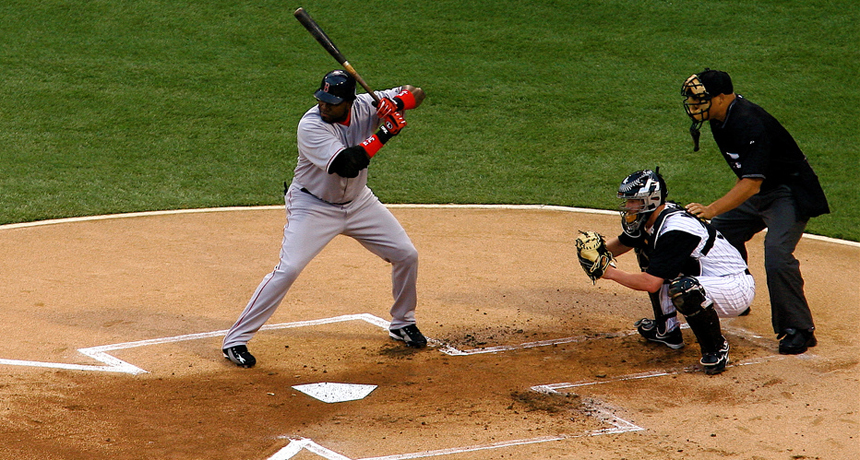Baseball: Keeping your head in the game
Successful hitters adjust their head movements to track incoming pitches

New experiments found that college baseball players tracked most of an incoming pitch by moving their heads. Here, David Ortiz of the Boston Red Sox watches for an incoming pitch.
SecondPrint Productions
Every baseball player, from T-ball tots to major leaguers, has heard the same advice: Keep your eye on the ball. For big league batters, that’s no easy task. Pitches scorch in at 145 kilometers (90 miles) per hour. That means they reach the plate less than half a second after leaving a pitcher’s hand. For a bat to connect with the ball, players have to be fast and strong. And, it now turns out, they also have to use their heads.
In a new experiment, college-level baseball players watched incoming pitches. For most of the pitch, the batters relied on small head movements even more than they relied on eye movements. But at the tail end of the pitch, on average, the players’ eyes moved much more than their heads.
“Believe it or not, most players aren’t very good at seeing the ball,” says Bill Harrison. This Laguna Beach, Calif., optometrist has worked with major league players for more than four decades. And, he notes, “If high school, college, and lower-minor-league players could improve their ability to see the ball with their eyes, it would improve their performance.”
Nicklaus Fogt of the Ohio State University College of Optometry, in Columbus, led the new study. He and his coworker Aaron Zimmerman asked 15 college baseball players to track incoming pitches. Each player assumed a batting stance and held a bat, but didn’t swing. He just watched as the balls came at him.
A pitching machine called a Flamethrower flung each pitch from nearly 45 feet away. To limit risks, it hurls tennis balls — not hard balls.
Each player wore tight goggles fitted with a camera. It tracked its wearer’s eye movements. A helmet containing sensors also measured how much each ballplayer moved his head as he tracked the incoming ball.
These test instruments collected movement data at six different times during a pitch. The amount of movement was measured in degrees. A degree is a unit of angular measurement. One degree represents a small rotation, and 360 degrees represents a full circle.
The data showed that by the time the ball was about 5.3 meters (17.5 feet) from the Flamethrower — the first measuring point — a player’s eyes had moved only two-tenths of 1 degree. Their heads had moved just 1 degree on average at that point. By the time the ball had traveled about 12 meters (40.6 feet), the players’ heads had turned 10 degrees. Meanwhile, their eyes had swiveled a mere 3.4 degrees. But in the last four feet of the pitch, on average, players’ eyes moved through more than 9 degrees — while their heads moved less than 5 degrees.
The researchers describe their findings in the February issue of Optometry and Vision Science.
Two other experiments — one conducted in 1954 and another in 1984 — had measured players’ eye and head positions during pitches. Harrison, the doctor who was not a part of the new experiment, says the Ohio State tests use additional data, and from thousands of pitches, to confirm those earlier findings. In other words, he says the new study didn’t deliver any new surprises. Indeed, the take-home message was the same, he says: “Batters need to use their heads.”
Fogt says he’s now working on better understanding the role of head movements. That means, for example, determining whether players who swing at a ball watch in the same way as did those college players in the lab. In follow-up studies, he’ll be investigating the balance between head and eye movement in more realistic settings. In the end, he’d also like to translate such findings into useful training tips.
“Our ultimate goal is to see if we can figure out what people do, and then teach novices to do what the experts do,” he says.
Power Words
degree A unit of measurement of angles, one three-hundred-and-sixtieth of the circumference of a circle.
optometry The practice or profession of examining the eyes for visual defects.
trajectory The path taken by a projectile moving through space and time.







